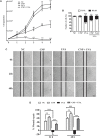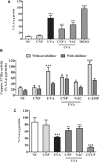Ceria Nanoparticles Decrease UVA-Induced Fibroblast Death Through Cell Redox Regulation Leading to Cell Survival, Migration and Proliferation
- PMID: 33102462
- PMCID: PMC7546350
- DOI: 10.3389/fbioe.2020.577557
Ceria Nanoparticles Decrease UVA-Induced Fibroblast Death Through Cell Redox Regulation Leading to Cell Survival, Migration and Proliferation
Abstract
Exposure to ultraviolet radiation is a major contributor to premature skin aging and carcinogenesis, which is mainly driven by overproduction of reactive oxygen species (ROS). There is growing interest for research on new strategies that address photoaging prevention, such as the use of nanomaterials. Cerium oxide nanoparticles (nanoceria) show enzyme-like activity in scavenging ROS. Herein, our goal was to study whether under ultraviolet A rays (UVA)-induced oxidative redox imbalance, a low dose of nanoceria induces protective effects on cell survival, migration, and proliferation. Fibroblasts cells (L929) were pretreated with nanoceria (100 nM) and exposed to UVA radiation. Pretreatment of cells with nanoceria showed negligible cytotoxicity and protected cells from UVA-induced death. Nanoceria also inhibited ROS production immediately after irradiation and for up to 48 h and restored the superoxide dismutase (SOD) activity and GSH level. Additionally, the nanoceria pretreatment prevented apoptosis by decreasing Caspase 3/7 levels and the loss of mitochondrial membrane potential. Nanoceria significantly improved the cell survival migration and increased proliferation, over a 5 days period, as compared with UVA-irradiated cells, in wound healing assay. Furthermore, it was observed that nanoceria decreased cellular aging and ERK 1/2 phosphorylation. Our study suggests that nanoceria might be a potential ally to endogenous, antioxidant enzymes, and enhancing the redox potentials to fight against UVA-induced photodamage and consequently modulating the cells survival, migration, and proliferation.
Keywords: antioxidant; nanoceria; photoaging; ultraviolet radiation; wound healing.
Copyright © 2020 Ribeiro, de Oliveira, Singh, Sakthivel, Neal, Seal, Ueda-Nakamura, Lautenschlager and Nakamura.
Figures






Similar articles
-
Cerium Oxide Nanoparticles Conjugated with Tannic Acid Prevent UVB-Induced Oxidative Stress in Fibroblasts: Evidence of a Promising Anti-Photodamage Agent.Antioxidants (Basel). 2023 Jan 12;12(1):190. doi: 10.3390/antiox12010190. Antioxidants (Basel). 2023. PMID: 36671052 Free PMC article.
-
Dithiothreitol reduces oxidative stress and necrosis caused by ultraviolet A radiation in L929 fibroblasts.Photochem Photobiol Sci. 2024 Feb;23(2):271-284. doi: 10.1007/s43630-023-00516-z. Epub 2024 Feb 2. Photochem Photobiol Sci. 2024. PMID: 38305951
-
Engineered nanoceria modulate neutrophil oxidative response to low doses of UV-B radiation through the inhibition of reactive oxygen species production.J Biomed Mater Res A. 2021 Dec;109(12):2570-2579. doi: 10.1002/jbm.a.37251. Epub 2021 Jun 26. J Biomed Mater Res A. 2021. PMID: 34173708
-
Redox Active Cerium Oxide Nanoparticles: Current Status and Burning Issues.Small. 2021 Dec;17(51):e2102342. doi: 10.1002/smll.202102342. Epub 2021 Aug 6. Small. 2021. PMID: 34363314 Review.
-
Nanoceria: an innovative strategy for cancer treatment.Cell Mol Life Sci. 2023 Jan 19;80(2):46. doi: 10.1007/s00018-023-04694-y. Cell Mol Life Sci. 2023. PMID: 36656411 Free PMC article. Review.
Cited by
-
Reactive oxygen species (ROS) scavenging biomaterials for anti-inflammatory diseases: from mechanism to therapy.J Hematol Oncol. 2023 Nov 30;16(1):116. doi: 10.1186/s13045-023-01512-7. J Hematol Oncol. 2023. PMID: 38037103 Free PMC article. Review.
-
Functionalized Prussian Blue Nanozyme as Dual-Responsive Drug Therapeutic Nanoplatform Against Maxillofacial Infection via Macrophage Polarization.Int J Nanomedicine. 2022 Nov 30;17:5851-5868. doi: 10.2147/IJN.S385899. eCollection 2022. Int J Nanomedicine. 2022. PMID: 36474527 Free PMC article.
-
Peroxidase-like Activity of CeO2 Nanozymes: Particle Size and Chemical Environment Matter.Molecules. 2023 Apr 29;28(9):3811. doi: 10.3390/molecules28093811. Molecules. 2023. PMID: 37175221 Free PMC article.
-
Reactive oxygen species-scavenging nanomaterials for the prevention and treatment of age-related diseases.J Nanobiotechnology. 2024 May 15;22(1):252. doi: 10.1186/s12951-024-02501-9. J Nanobiotechnology. 2024. PMID: 38750509 Free PMC article. Review.
-
Cerium Oxide Nanoparticles Conjugated with Tannic Acid Prevent UVB-Induced Oxidative Stress in Fibroblasts: Evidence of a Promising Anti-Photodamage Agent.Antioxidants (Basel). 2023 Jan 12;12(1):190. doi: 10.3390/antiox12010190. Antioxidants (Basel). 2023. PMID: 36671052 Free PMC article.
References
LinkOut - more resources
Full Text Sources
Research Materials
Miscellaneous

